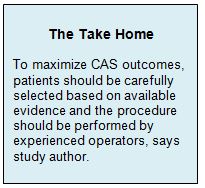Key Points:
- Canadian study examines trends in carotid revascularization over 12-year period
- When pivotal trials were published, overall revascularization and CEA rates fell while CAS rate rose
Results of clinical trials have encouraged physicians to increase the use of carotid artery stenting (CAS) at the expense of endarterectomy (CEA) for significant carotid artery atherosclerosis over a 12-year period, according to Canadian data published online November 10, 2016, in Stroke. The overall rate of carotid revascularization also fell.
But interventionalists could potentially boost outcomes further by basing procedure selection even more closely on published data, the study authors suggest.
Mohamad A. Hussain, MD, of the University of Toronto and St. Michael's Hospital (Toronto, Canada), and colleagues conducted a population-level time-series analysis of all 16,772 patients who underwent carotid revascularization in Ontario between 2002 and 2014. Of these patients, 14,384 (86%) underwent CEA and 2,378 (14%) CAS.
There was a significant decrease in rates of carotid revascularization overall and CEA in particular, with a concomitant increase in CAS over the 12-year period during which several pivotal trials were published (table 1).
Table 1. Shift in Procedure Rates (per 10,000 Patients) – April 2002 to First Quarter of 2014
|
|
Percent Change |
P Value |
|
Carotid Revascularization |
- 29% |
< .001 |
|
CEA |
- 36% |
< .001 |
|
CAS |
+ 72% |
.006 |
The CAS rate increased markedly (P = .01) following publication of the SAPPHIRE trial in 2004 and remained relatively unchanged after subsequent randomized trials were published in 2006 (P = .11) and 2010 (P = .34). Use of CEA, however, decreased after trials published in 2006 (P = .04) and 2010 (P = .005).
Trends Likely Not Unique to Ontario
In an email to Neurovascular Exchange, Dr. Hussain said that while the data stemmed only from procedures that took place in Ontario, Canada, they likely also represent trends occurring elsewhere. “Several authors have also noted that carotid endarterectomy is declining in the US, whereas carotid stenting has increased over the last decade,” he pointed out. “However, it would be interesting to know how these trends have changed in other countries when stratified by patient symptomatic status and operator specialty.”
In Ontario, the investigators found that physicians are performing fewer revascularizations for asymptomatic carotid stenosis. In addition, “neurosurgeons are moving away from endarterectomy and towards more stenting, whereas vascular surgeons continue to perform endarterectomy at a stable rate but perform almost no stenting,” reported Dr. Hussain.
He added that the trends observed here reflect “a cautious uptake of stenting technology by Ontario physicians, who likely offer this procedure to patients not suitable for surgical endarterectomy, which is still considered the gold standard by many.”
Population-based studies have suggested higher rates of stroke and death with CAS in the real world compared with trials. To minimize this, Dr. Hussain recommends the recently published strategy of selecting patients for stenting based on the presence of suitable anatomy and features that are known to affect surgical risk as well as ensuring the procedure is performed by an experienced operator with established outcomes equivalent to CEA.
While the study findings suggest that clinical practice does appear to be closely mimicking published evidence, Dr. Hussain expressed concern that “stenting increased among older patients above the age of 75, despite strong evidence from clinical trials indicating that endarterectomy is safer than stenting in older patients.
“This is likely related to unfavourable vessel and plaque characteristics for stenting among the elderly leading to higher rates of stroke and death,” he suggested. “Therefore, clinicians need to exercise caution before offering this therapy to older patients.”
Source:
Hussain MA, Mamdani M, Tu JV, et al. Impact of clinical trial results on the temporal trends of carotid endarterectomy and stenting from 2002 to 2014. Stroke. 2016;Epub ahead of print.
Disclosures:
· Dr. Hussain reports no relevant conflicts of interest.


